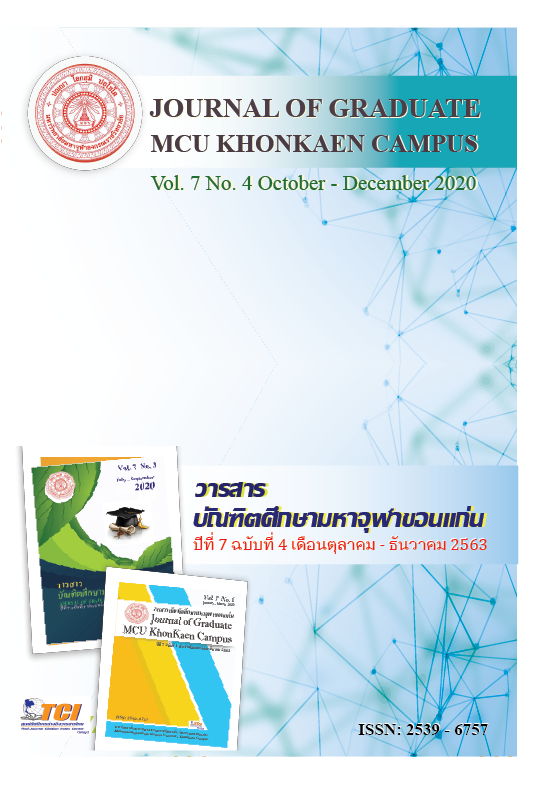COMMUNICATION FOR PROPAGATION OF BUDDHIST RADIO STATIONS IN UDON THANI PROVINCE
Main Article Content
Abstract
The aims of this research were: 1) to study Buddhistmethods for propagationin Buddhism; 2) to study the conditions of Buddhism’s propagation of Buddhist radio stations in Udonthani province; 3) to study the Buddhist method for propagation of Buddhist radio stations in Udonthani province. This study was carried out by means of a qualitative research methodology through investigating documents, academic works, texts, theses and research works together with fieldwork research to collect the data by interviews.
The research results were as follows:
The communication for dissemination of teachings during the time of the Buddha wasa one-on-one mission.Those with wondering thoughts wanted answers, they would seek for them themselves. The Buddha taught three miracles (pāṭihāriya): marvel of psychic power (iddhi-pāṭihāriya), marvel of mind-reading (ādesanā-pāṭihāriya) and marvel of teaching (anusāsanī-pāṭihāriya) as importance. The development of information technology such as radio, television, internet, he wishes all beings to be free from suffering and find true happiness.
The study of the conditions of the conditions of communication for Buddhism’s propagation of Buddhist radio stations in Udonthani province revealed that in terms of the management of the radio broadcasting stations in Buddhism, the public should be allowed to participate and given an opportunity in management of the pattern of the dhamma shows.The organizational structure should be flexible to the current situation, suitable to the social context according to the principles of Buddhist disciplines.
The Buddhist communication method for propagation of Buddhist radio stations in Udonthani province consisted of 1) access: broadcasting to reach communities, impartiality, merit-making events in line with the community activities andpropagation goals; 2) participation: presenting, making decisions, formulating policies, making recommendations, and evaluating; 3) diversity: presenting media and presenters; 4) localization: content; 5) independence: namely administration and operation.
Article Details
References
มหาจุฬาลงกรณราชวิทยาลัย. (2539). พระไตรปิฎกภาษาไทย ฉบับมหาจุฬาลงกรณราช วิทยาลัย. กรุงเทพมหานคร : โรงพิมพ์มหาจุฬาลงกรณราชวิทยาลัย.
พระศรีปริยัติโมลี (สมชัย กุสลจิตฺโต). (2547). พุทธศาสตร์ร่วมสมัย 2. (พิมพ์ครั้งที่ 2). กรุงเทพมหานคร : โรงพิมพ์มหาจุฬาลงกรณราชวิทยาลัย.
บัญชายุทธ นาคมุจลินท์. (2555). วิเคราะห์การบริหารองค์กรในทางพระพุทธศาสนาของ ศูนย์การ เผยแผ่พระพุทธศาสนาประจำจังหวัดอุทัยธานี. วิทยานิพนธ์พุทธศาสตร ดุษฎีบัณฑิต. บัณฑิตวิทยาลัย : มหาวิทยาลัยมหาจุฬาลงกรณราชวิทยาลัย.
จำนงค์ อดิวัฒนสิทธิ์. (2548). สื่อสารมวลชนกับความมั่นคงแห่งพระพุทธศาสนา. รายงาน วิจัย. สถาบันวิจัยพุทธศาสตร์ : มหาวิทยาลัยมหาจุฬาลงกรณราชวิทยาลัย,
พระมหาสุริยา วรเมธี และคณะ. (2551). ศึกษาแนวคิดและหลักการในการเผยแผ่ พระพุทธศาสนาของพระธรรมทูตไทยในสหรัฐอเมริกา. รายงานการวิจัย. คณะครุ ศาสตร์ : มหาวิทยาลัยมหาจุฬาลงกรณราชวิทยาลัย.
พระเทพรัตนสุธี (สมศักดิ์ โชตินฺธโร). (2559). กลยุทธการปกครองคณะสงฆ์ภาค 1. วิทยานิพนธ์พุทธศาสตรดุษฎีบัณฑิต สาขาวิชาการจัดการเชิงพุทธ. บัณฑิตวิทยาลัย : มหาวิทยาลัยมหาจุฬาลงกรณราชวิทยาลัย.

